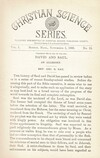

Are you sure?
This bookmark will be removed from all folders and any saved notes will be permanently removed.
David and Saul: an allegory
Originally published in the November 1, 1889 issue of the Christian Science Series (Vol. 1, No. 13)
The history of Saul and David has passed in review before us in a series of recent Sunday-school studies. Before dismissing this part of the Bible narrative, it seems wise to use it allegorically, and to make such an application of the story as may best lead to a broad survey of the progress of the world towards its final and complete redemption.
Saul was the anointed of the Lord, as was David also. The former had occupied the throne of Israel some years before the selection of the latter. The word anointed, as translated from the Hebrew, has the same meaning as Christ, rendered from the Greek. The anointing of each by Samuel the prophet was the outward act by which they were vested with kingly power. An obligation was involved in this divine appointment to kingship. Saul was expected to regard religiously the commandments given by Moses. As a personal or visible king, he was to rule over a people who had no other conception than that of personality in the flesh. The commandments to be obeyed were literal and concerned the relations of mortal men to their fellows, and to Jehovah, their God. A strict obedience to these by Saul, and their enforcement on his subjects, would have been regarded as righteousness, and he would have retained the throne undisturbed had he been faithful to the injunctions of Samuel.
Enjoy 1 free Sentinel article or audio program each month, including content from 1898 to today.
JSH Collections
This article is included in:
1889 - PAMPHLET
Christian Science Series, Vol. 1, No. 13
JSH-Online has hundreds of pamphlets, anthologies, and special editions for you to discover.


